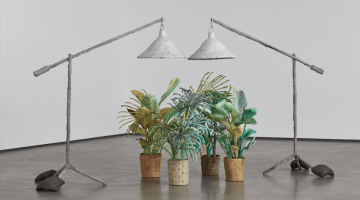Contributed by Robert Strang
Located in the heart of the ‘big smoke’ the Tate Modern is the most visited modern art gallery in the world pulling in an average 4.7 million viewers a year, currently celebrating the rip-roaring success of Damien Hirst’s recent show, their most visited solo show in Tate history. Their follow-up exhibition named ‘A Bigger Splash: Painting after Performance’, named after David Hockney’s iconic 1967 work, aims to address the dynamic alliance between performance and painting since 1950. A rather more challenging subject after Damien’s pop playful, gruesome, bright coloured, butterfly event. The question is will ‘A Bigger Splash’ be a belly-flop or a tidal wave of triumph? (With puns like that how could you not carry on reading. Please carry on reading, I promise I won’t do it again).
In the first room you are greeted by two mammoth pieces from the art sphere, ‘A Bigger Splash’ by David Hockney and Jackson Pollock’s ‘Summer Time number 9a’ 1948, this work is displayed lying on its back on a raised plinth, the intention being to show that his works where created on the ground. The room also has Pollocks 51 video of the documentation of his expressive paint style and Hockney’s more elaborate style of documentation showing naked men leaping into a swimming pool in slow motion intercut with the man him-self at work directed by Jack Hazan.
The next 4 rooms consist of collections of artists’ work broken up into individual titles: Action Painting, Viennese Actionism, Four Dimensional Painting and Transformer. These rooms are highly insightful into the history of attacking the traditional limits of the canvas with works by Yves Klein, Kazuo Shiraga, Sanja Ivekovic and the phenomenal Sam Gilliam to name a few. All the works in the first 5 rooms have an educational feel, with film or photography showing how the individual works were made, the exhibition aims to show why the process is so integral to the painting’s final aesthetic significance.
In the room containing great works by Cindy Sherman, Bruce Nauman and Lynn Hershman I saw the most disturbing thing in the whole exhibition, a group of kids being herded round like post lobotomized patients waiting for their afternoon feeding session. The exhibition has the power and potential to grasp these poor children with some really sublime work, but the display lacks the energy that these pieces possess, shown in low lighting like the Tate is having problems paying the electrical bills.
The rest of the show is broken up into individual artists’ work. The most impressive rooms contained work by Edward Krasinski, Marc Camille Chaimowicz and Lucy McKenzie. Edward Krasinski’s displays blue tape at a fixed height stuck on the walls, attached to his work ‘Untitled’ a piece consisting of 12 hanging mirrors linking the viewer, object and gallery surroundings making you highly aware of all three. Marc Camille Chaimowicz’s ’Jean Cocteau’ an instillation of how he would conceive Jean Cocteau’s bedroom, describes the work as ‘a furnished interior that obliquely references his poetics’. The work is highly engaging, spotting references to Duncan Grant and Edouard Vuillard and artists who were working after Cocteau’s death including Warhol and Wolfgang Tillman. By far the best individual artist’s room was Lucy McKenzie’s beautiful full-scale recreation of a traditional-town house divided up into individual private rooms focusing on her wide use of techniques ranging from outside the contemporary art world such as sign and faux marble painting. The paintings were also used in Lucile Desamory’s film ‘ABRACADABRA” and act as the remnants of the event where art is performance.
After viewing the show in its entirety and seeing such a stunning gathering of important pieces in art history I am left with an over-riding feeling of doubt. Not only does the show seem to lack a certain cohesion in all 13 rooms but the text next to the Jackson Pollock 51 video that greets you at the beginning of the show states how Pollock hated being documented on film, that he felt self-conscious and a phoney in front of the camera. This then seems to give the whole show an underlying quality that all seems not quite genuine based on the fact that most of the show consisted of final pieces and documentation of the event.
Then again, we know that Pollock was prone to a little hissy fit here and there. (Thanksgiving 1951)







